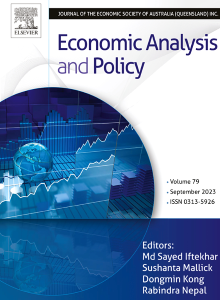企业和贷款人的特征在货币政策传导中重要吗?来自韩国贷款水平数据的证据
IF 8.7
2区 经济学
Q1 ECONOMICS
引用次数: 0
摘要
本文研究了企业贷款对货币政策冲击的反应如何随企业规模、贷款人类型和贷款类型的不同而变化。通过结合韩国信用登记数据,我们采用独特的方法扩展了当地的预测方法,我们发现货币紧缩减少了企业间的定期贷款和信贷额度的使用,但与小企业相比,大公司的减少幅度相对较小,在某些情况下甚至有所增加。我们将此归因于它们更大的信誉和更丰富的可抵押资产。此外,大公司通过增加银行信贷额度或从非银行机构获得定期贷款来抵消银行定期贷款的减少,这是一种“水床效应”。我们的研究结果表明,大企业的存在和非银行部门的扩张可能会减弱货币政策传导中的信贷渠道,货币紧缩扩大了企业获得融资的差距。在这种情况下,我们的研究结果强调需要有针对性的政策干预,以减轻货币政策导致的部门差异的扩大。本文章由计算机程序翻译,如有差异,请以英文原文为准。
Do firm and lender characteristics matter in monetary policy transmission? Evidence from Korean loan-level data
This paper investigates how corporate lending responses to monetary policy shocks vary by firm size, lender type, and loan type. With our unique approach of extending local projection methodology by incorporating Korean credit registry data, we find that monetary tightening reduces both term loans and credit line usage across firms, yet large firms exhibit a relatively smaller decrease – or in some cases, an increase – compared to smaller firms. We attribute this to their greater creditworthiness and more abundant collateralizable assets. Moreover, large firms offset reduced term loans from banks by either increasing bank credit line drawdowns or substituting with term lending from non-banks–a “waterbed effect”. Our findings suggest that the presence of large firms and the expansion of the nonbank sector may attenuate the credit channel in the transmission of monetary policy, and that monetary tightening widens disparities in firms’ access to financing. In this light, our findings highlight the need for well-targeted policy interventions to mitigate the amplification of sectoral disparities induced by monetary policy.
求助全文
通过发布文献求助,成功后即可免费获取论文全文。
去求助
来源期刊

Economic Analysis and Policy
ECONOMICS-
CiteScore
9.80
自引率
9.20%
发文量
231
审稿时长
93 days
期刊介绍:
Economic Analysis and Policy (established 1970) publishes articles from all branches of economics with a particular focus on research, theoretical and applied, which has strong policy relevance. The journal also publishes survey articles and empirical replications on key policy issues. Authors are expected to highlight the main insights in a non-technical introduction and in the conclusion.
 求助内容:
求助内容: 应助结果提醒方式:
应助结果提醒方式:


